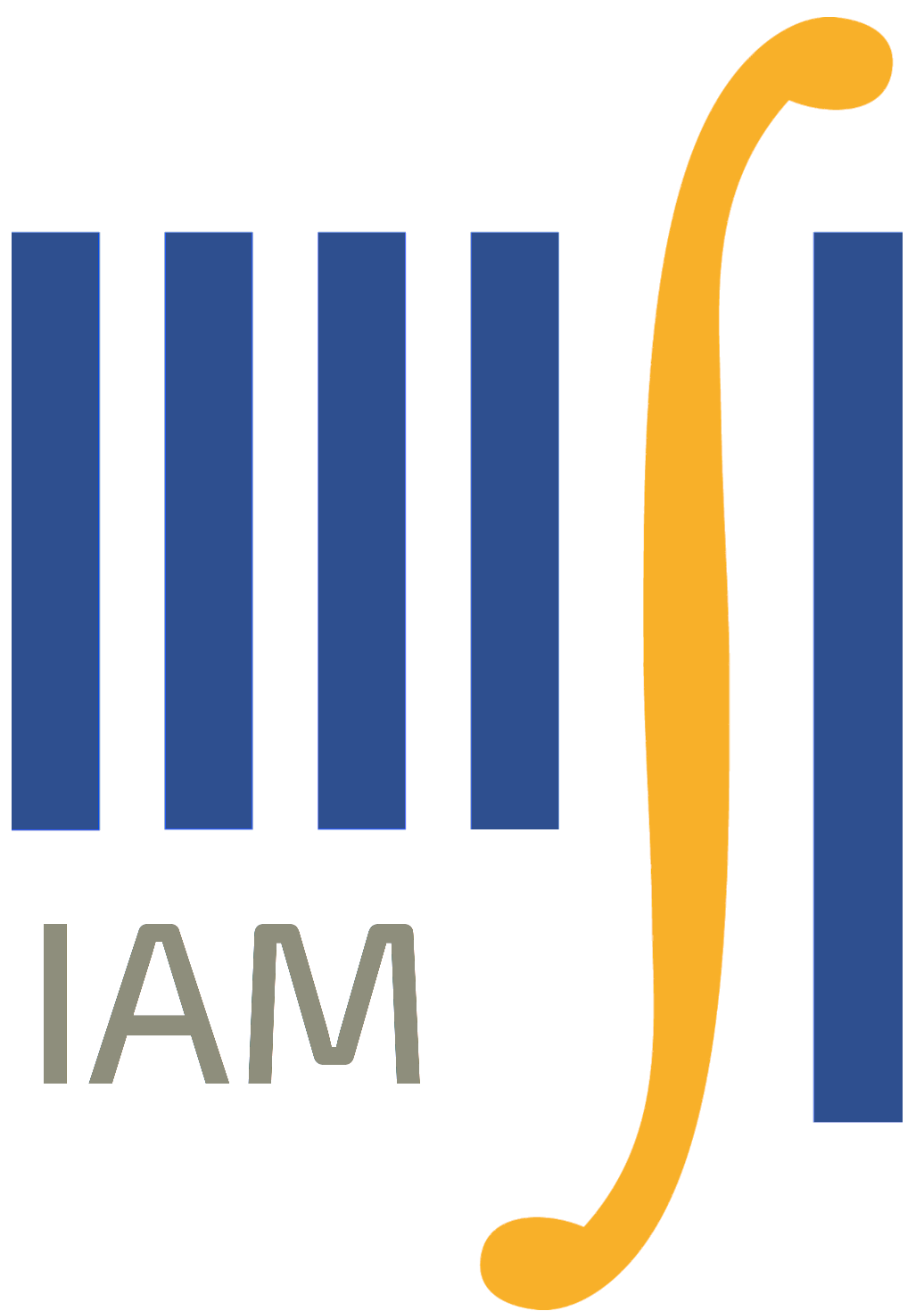Oberseminar Analysis Winter 2013/14
Organizers: B. Zwicknagl, S. Conti, H. Koch, S. Müller, B. Niethammer, M. Rumpf, B. Schlein, C. Thiele, J. López-Velázquez
- Thursday, October 24, 2013, 2:15 pm, Lipschitz-Saal
Wenhui Shi
Regularity of the free boundaries for the elliptic thin obstacle
problem
I will describe an ongoing project on the higher regularity of
the free boundaries in the elliptic thin obstacle problem.
The main method we use is the appropriate generalization of the partial
hodograph-Legendre transformation, which was used by Kinderlehrer and Nirenberg in the classical obstacle problem. - Thursday, October 31, 2013, 2:15 pm, Lipschitz-Saal
Lisa Beck
Duality, regularity and uniqueness for BV-minimizers
Abstract - Thursday, November 7, 2013, 2:15 pm, Lipschitz-Saal
Peter Bella (MPI MiS, Leipzig)
Wrinkling of a Stretched Annular Elastic Thin Sheet - Identification of the Optimal Scaling Law for the Ground State Energy
In [Bella & Kohn: Wrinkles as the result of compressive stresses in an annular thin film, to appear in CPAM] we identified the optimal scaling law of the minimum of the elastic energy of a stretched annular thin elastic sheet. In this talk I will describe the next step towards the understanding of this problem -- I will identify the optimal prefactor in the scaling law. Moreover, I show that this prefactor can be characterized as a minimum of a much simpler (scalar) variational problem. - Thursday, November 14, 2013, 2:15 pm, Lipschitz-Saal,
Evelyne Miot (Orsay)
Some examples of dynamics for nearly parallel vortex filaments
A system of equations combining the 1D Schrödinger equation and the point
vortex system has been derived by Klein, Majda and Damodaran to modelize
the evolution of nearly parallel vortex filaments in 3D incompressible
fluids. In this talk I will describe some dynamics for this system such as
travelling waves, collisions and finite-time blow-up. I will in particular
present some numerical results concerning pairs of filaments. This is
joint work with Valeria Banica and Erwan Faou. - Thursday, November 14, 2013, 3:30 pm, Lipschitz-Saal,
Laurent Desvillettes (ENS Cachan)
Application of duality methods to the problem of gelation in coagulation-fragmentation equations
Gelation is a phenomenon which occurs in polymers. It corresponds to
a sudden phase change and the apparition of a gel in a liquid originally composed of monomers. This phenomenon has been studied a lot in the spatially homogeneous context, and is directly related to the asymptotic behavior of coagulation coefficients in the so-called Smoluchowsky equation (in fact an infinite number of ODEs including infinite series for each equation). We propose an approach enabling to understand some features of the spatially inhomogeneous context, in which the ODEs are replaced by reaction-diffusion equations. This approach uses duality lemmas first devised by M. Pierre and D. Schmitt for reaction diffusion systems with a finite number of equations. - Thursday, November 21, 2013, 2:15 pm, seminar room 2.040
Diogo Arsénio (Paris 7)
Velocity averaging lemmas and beyond
Velocity averaging lemmas are used to study compactness, regularity and dispersion properties of solutions to kinetic transport equations. They have found a variety of applications in kinetic theory. After an overview of the principles leading to the basic averaging lemmas, we will explore modern methods yielding new and refined results. In particular, we will see how a precise microlocal analysis of the transport of frequencies provides a precise understanding of dispersion and hypoellipticity. - Thursday, November 28, 2013, 2:15 pm, Lipschitz-Saal
Gustavo de Oliveira (Bonn)
Quantum dynamics of a particle constrained to lie on a surface
We will consider the quantum dynamics of a charged particle in Euclidean space subjected to electric and magnetic fields under the presence of a potential that forces the particle to stay close to a compact surface. It happens that, as the strength of this constraining potential tends to infinity, the motion of this particle converges to a motion generated by a Hamiltonian over the surface superimposed by an oscillatory motion in the normal directions. We will discuss this statement and the main steps of its proof. Our result extends previous results by allowing magnetic potentials and more general constraining potentials. - Thursday, December 5, 2013, 2:15 pm, Lipschitz-Saal
Flaviana Iurlano
Asymptotic analysis of certain damage models in linearized elasticity
We consider a variational model for damaged elastic materials. This model depends on three small parameters, the first related to the cost of the damage, the second to the width of the damaged regions, and the third
preventing the material to be totally damaged. We first investigate the Gamma-limit of the corresponding functionals in the case of antiplane shear, as these parameters tend to zero. We find that the limit functional corresponds to a model for fracture mechanics or for plasticity, depending on the asymptotic ratios of the three parameters. The extension of some interesting results from the antiplane to the general case of linearized elasticity in dimension n is the object of the second part of the talk. As we shall see, this is not a straightforward generalization of the scalar case, requiring the involvement of the new functional space GSBD and the proof of suitable density properties. - Thursday, December 19, 2013, 2:15 pm, Lipschitz-Saal,
Niels Benedikter
Mean-Field Evolution of Fermionic Systems
Physical systems typically consist of a large number of interacting particles, making it difficult to predict measurements from the time-dependent Schroedinger equation. Therefore one is interested in deriving effective evolution equations approximating the quantum mechanical evolution. We consider systems of fermions in the mean-field limit (high density and weak interaction) and prove that Hartree-Fock theory approximates the time evolution. We point out a semiclassical structure in typical initial data which is crucial for controlling the approximation up to arbitrary times. (This is joint work with Marcello Porta and Benjamin Schlein.) - Thursday, January 16, 2014, 2:15 pm, Lipschitz-Saal
Heiner Olbermann
Energy scaling law for the regular cone
Abstract - Thursday, January 16, 2014, 3:30, Lipschitz-Saal
Matteo Focardi (Università degli Studi di Firenze)
Higher integrability of the gradient and regularity issues for local minimizers of the Mumford-Shah functional in 2d
In this talk I shall focus on the higher integrability
property enjoyed by the approximate gradients of local minimizers
of the 2d Mumford-Shah energy.
One of the key steps of the proof is the analysis of sequences of
minimizers having vanishing L^1 norm of the gradients, for which
we characterize the compactness properties.
Our ideas lead to a simplified proof of the Ambrosio-Fusco-Hutchinson's estimate of the Hausdorff dimension of the singular set of Mumford-Shah minimizers. - Thursday, January 23, 2014, 2:15 pm, Lipschitz-Saal
Giuseppe Genovese (Paris 7)
Saddle-Point Principles in Neural Networks
I will review the results on neural networks and bipartite spin glasses obtained in the last years in some papers in collaboration with A. Barra, F. Guerra and D. Tantari. I will focus on the parallelism between the perceptron models and bipartite spin glasses, giving a characterisation of the Replica Symmetric regime in terms of min-max variational principles. Moreover, I will discuss an interesting decomposition valid at high temperature of the free energy for bipartite spin glasses in terms of the free energies relative to the mono-partite models. - Thursday, January 30, 2014, 2:15 pm, Lipschitz-Saal
Miroslav Bulicek (Charles University in Prague)
On scalar hyperbolic laws with discontinuous fluxes
We consider the Cauchy problem for conservation laws with a flux that can have jump discontinuities in an unknown function. We introduce new concepts of entropy weak and measure-valued solution that are consistent with the standard ones if the flux is continuous. Having various definitions of solutions to the problem, we then answer the question what kind of properties the flux should possess in order to establish the existence and/or uniqueness of solution of a particular type. In any space dimension we establish the existence of measure-valued entropy solution for a flux having countable jump discontinuities. Under the additional assumption on the Hoelder continuity of the flux at zero, we prove the uniqueness of entropy measure-valued solution, and as a consequence, we establish the existence and uniqueness of weak entropy solution. Finally, we extend the theory also on a class of fluxes that are also x-dependent. - Thursday, February 6, 2014, 2:15 pm, Lipschitz-Saal
Junfeng Li (Bejing Normal University and Bonn)
Galilean invariance and global wellposedness of the 3-D
Kadomtsev-Petviashvili II problem
In this talk, we will present some new constructions related to the
scaling and the Galilean invariance of the KP II problem. By using
these symmetries, we obtain a global well posed result for the 3-D KP
II problem. The solutions are constructed in function spaces which
invariant with respect to the symmetries of the equation.


